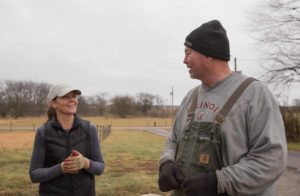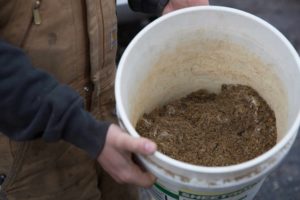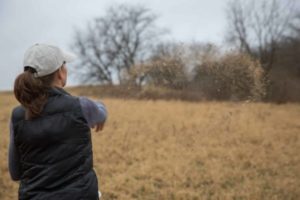
“The Journey started when I decided to become an Organic farm. In a short time I started to see changes in the farm, new life began of all types, above and below the surface of the farm. Then the questions began, what more should I do?” Steve Buxton Said.
Steve is talking about his Two Mile Creek Organic Farm in Sullivan, Illinois where last week, PRN’s Kim Erndt-Pitcher and Robert Hirschfeld visited to jump start his farm’s pollinator habitat by sowing seeds for spring perennials.
“Much of the Illinois landscape is in agricultural production,” Kim said. She is PRN’s Habitat and Agriculture Programs Specialist. “By bringing pollinator habitat back to the farm, we are ensuring that the pollinators we depend on for crop production and ecosystem function have adequate resources for survival.”

This simple seeding started with native seeds Kim and her husband collected from about five acres of restored prairie on their small farm in southern Illinois. The seed mix consists of a diverse mix of perennials including early flowering plants like penstemon and white wild indigo; long blooming plants like mountain mint; summer blooming ones such as compass plant, cup plant, yellow wingstem, culvers root, blazing star, and coneflowers, and late blooming plants such as asters, goldenrods, and Joe-Pye weed. They also included three types of milkweed to promote habitat for monarch butterflies.
Planting early, mid and late blooming flowers will provide vegetation, pollen, and nectar for native pollinators throughout the growing season. The key for creating valuable habitat is diversity. The more diversity in your plant selection, the more likely you are to have a broader range of pollinators and other invertebrates. Not only will Steve gain the benefits of native pollinators to his farm, but the habitat that he creates will also be home to beneficial insects, which prey on crop pests. Pollinators and beneficial insects come in all shapes and sizes. Just consider that there are over 4,000 species of bees that are native to North America. These bees can be as small as a gnat or as big as the top part of your finger. The more diverse the flower shapes, sizes, and blooming times you provide, the greater variety of insects you can provide resources for.
Two Mile Creek Organic Farm had plans to seed along two waterways, a small set aside, and a demonstration plot on their main farm. Approximately five acres of their farm was seeded with native perennial flowering forbs and grasses.
This is just beginning of Steve’s efforts to expand pollinator habitat on his farms.
“We have already started planning for the ‘more and better’ additional areas,” Steve said. “I would like to call the next phase the ‘B.B.R.’ Benifical Bug Resorts, buffers designed and planted around and in the fields to welcome the friendly bugs. By listening, watching, tasting, and digging I have seen the need is really in creating a regenerating community of life for the farm.”

As part of PRN’s efforts to increase the acres of valuable wildlife and pollinator habitat throughout Illinois, we will continue to work with private landowners and farmers, and members of the IDEA Farm Network to protect our water and wildlife resources for generations to come. We are thankful for farmers like Steve that strive to regenerate their land, soil, and entire farming system.







